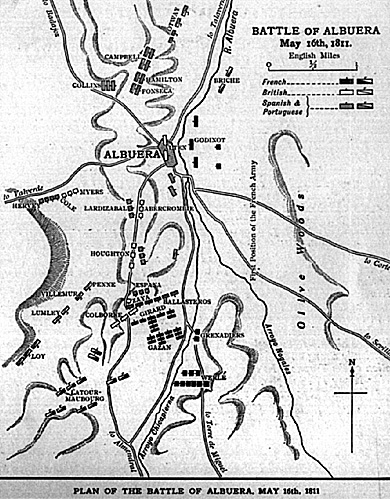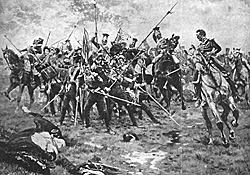The 23rd (Royal Welsh Fusileers)
Battle of Albuera
16th May 1811
by Colin Rogers, UK
| |
BackgroundDuring May 1811, General Beresford was besieging Badajoz when, on the 12th May, he was informed that Marshal Soult was advancing against him from the south with 25,000 men. Immediately abandoning the siege, he moved south east to the small town of Albuera, where he took up a defensive position that had been preselected by Wellington for this very purpose on 16th April the same year. During the night of 15th May, Beresford was joined by 14,000 Spanish troops under Generals Blake and Castanos, who agreed to serve under him. Beresford could now face Soult with some 37000 men with 50 guns. This force consisted of 12000 Portuguese, 15,000 Spanish and 10,000 British troops. The British contingent in the army comprised the 2nd Division, whose commander was Stewart, and the 4th Division under the command of Cole. The brigades within the 4th division were Kemmis's, Harveys and Myers, with Myers brigade consisting of two battalions of the 7th Royal Fusileers and the first battalion 23rd foot ( Royal Welsh Fusileers ), one of the original ' Minden ' battalions. The first battalion of the 23rd had arrived in the Peninsular on 12th December 1810, having previously been stationed at Nova Scotia. It was commanded by Lieutenant-Colonel Henry Walton Ellis, whose father had commanded the regiment in a previous tour of duty in the West Indies. Being a Fusileer regiment, and not previously engaged in permanent active service, they arrived in Portugal with 814 other ranks fit for duty, and they immediately joined Wellington in pursuing the French out of Portugal. When news came through that Badajoz was in French hands, the 23rd, as part of the 4th Division, were ordered to the area. However, to join Beresford at Badajoz meant the regiment had to march 110 miles to Portalegre, a journey that turned out to be most arduous. Lt. John Harrison, who celebrated his 23rd birthday on the march wrote of one days work..... "It was the most fatiguing day I ever felt. We marched 30 miles and had no meat for 2 days before or spirits, only a small portion of biscuit and water to support us.... the men were in a poor way, as most of them were barefoot" Beresford expected Soult to advance from the east, and he therefore made Albuera the centre of his position, which extended one mile to the left the town and two miles to the right. He also occupied a low ridge which ran through Albuera with all his troops facing the east. Having placed Altens K.G.L. brigade in Albuera, the British 2nd and 4th Divisions, with over 1000 cavalry, were positioned behind them. Blakes 12000 Spanish troops were to cover Beresfords right flank. The BattleSoult launched his attack early on the 16th May 1811, with Goudinots brigade demonstrating in front of Albuera, which lead to Beresford reinforcing his centre. Suddenly, the allied troops saw appearing from behind trees to their right, 8400 infantry, supported by artillery and 3000 cavalry. This was Girards V corps, advancing in mixed order, which engaged Zayas Spanish division. The Spanish troops, to their credit, stood their ground despite losing a third of their strength. The advantage of surprise, however, lay with the French. Beresford ordered Blake to change face and meet the threat, whilst the British second division moved to support the Spanish. For whatever reason, Blake failed to carry out Beresfords order to the letter, and it was with difficulty that the leading troops of the 2nd Division halted the French infantry, running into difficulties with the French cavalry. Consequently, the K.G.L. troops from Albuera were ordered forward in support of the British 2nd Division. At this point things were not going well for the allies. The battle at the centre of their line had reached stalemate, a tremendous rain had covered the field, and the French were preparing to assault the British right in force. It was now that Cole, whether on his own initiative or on that of others, led the British 4th division forward to the right of the line. Placing Portuguese troops on his flank to prevent the enemies cavalry from attacking him, the division made its way forward to the ridge of Albuera. Amongst the battalions nearest the ridge, positioned to the left of the front of the line, was the 1st Battalion, 23rd Foot, part of the Fusileer brigade. As they marched up to the ridge, they were met with a heavy fire of artillery, whilst waiting at the top were nine French battalions, over 5000 men strong, drawn up in three heavy columns. The British were outnumbered by nearly 3 to 1, but each fusileer battalion attacked a column head on. The 23rd Foot got to within musket shot of the French, whereupon they closed and deployed into line. The French had the advantage of the ground, and soon opened fire but the fusileers returned fire, came down to the charge and cheered. The French, being reinforced, continued the struggle as Harrison recalls.... "The contest soon became general and a most determined fire kept up on both side, so near as to be almost muzzle to muzzle.....this work lasted some time, they continuing to bring up fresh regiments, our brigade being much broken by its losses..." It was like two equally classed heavy weight boxers, trading punches for possession of the ring, with neither showing signs of tiring. Despite the ferocity of the exchange, the remnants of the fusileers clung to their ground they had won. As casualties mounted, the fusileers never forgot to keep their dressing. Blakeney recalled that.... " The men behaved most gloriously, never losing their ranks and closing to the centre as casualties occurred...." Slowly, the fusileers moved forward and after some time firing at each other at near point blank range, the French broke and left the ridge. This attack by the fusileers was instrumental in deciding the battle, and Soult soon withdrew his shattered army which had lost more than 7000 men. The British losses in this battle were staggering. Oman gives the total losses of the British contingent as 4159 out of a total of 10449 officers and men engaged, or 39 per cent of the total involved. Beresford was shattered by the carnage involved, and his first report on the battle to Wellington was so full of despair that the Duke returned it, with the instructions that it would not do, and for Beresford to rewrite it in the form of a victory. The casualties suffered by the 23rd Foot illustrate the desperate fight by the fusileers on Albuera ridge. Of the 733 officers and men who formed the battalion, 339 or 46per cent of the battalion strength are recorded as either killed or wounded. Included in the wounded were Lieutenant-Colonel Ellis who was " holding his bridle in his right hand and a musket ball entered the back and shattered the third and little fingers ", and Lieutenant Harrison who was shot through the thigh and taken to the rear. Many officers and writers have commented on the performance of the fusileers that day. Hardinge stated that... " ..the fusileers exceeded anything that the usual word gallantry can convey" whilst Cole himself found they displayed... "..an example of steadiness and heroic gallentry which history I believe cannot surpass." Perhaps the most dramatic and celebrated account of the action belongs to Napier who says... "The fusileer battalions, struck by the iron tempest, reeled and staggered like sinking ships. Suddenly and sternly recovering, they closed on their terrible enemies, and then was seen with what a strength and majesty a British soldier fights." However, the most fitting compliment must surely lie with the enemy himself. Soult, when discussing the action later spoke of the stubbornness displayed by the British that day... "There is no beating these troops, in spite of their generals. I always thought them bad soldiers, but now I am sure of it; for I turned their right, and penetrated their centre; they were completely beaten; the day was mine and yet they did not know it and would not run." For the 1st Battalion, 23rd Foot, this was their first major Peninsular War action, one in which they demonstrated their tenacity and fighting quality, rightly earning themeselves the battle honour ALBUERA. References and Suggested Reading List
Gates D. ( 1986 ) The Spanish Ulcer. A History of the Peninsular War. 
Back to Table of Contents -- First Empire #44 Back to First Empire List of Issues Back to MagWeb Master Magazine List © Copyright 1999 by First Empire. This article appears in MagWeb (Magazine Web) on the Internet World Wide Web. Other military history articles and gaming articles are available at http://www.magweb.com |
 "Oh, Albuera! Glorious field of grief!"
"Oh, Albuera! Glorious field of grief!"